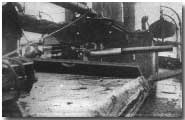Encyclopedia - Q-Ships
 Introduced towards the
close of 1914 by the British and French - and later deployed by the Italian
and Russians navies - Q-Ships were deployed as an initially although
decreasingly successful anti-submarine weapon. Alternatively referred
to as Special Service Ships or Mystery Ships, the purpose of Q-Ships was
straightforward: to trap enemy (usually German) submarines.
Introduced towards the
close of 1914 by the British and French - and later deployed by the Italian
and Russians navies - Q-Ships were deployed as an initially although
decreasingly successful anti-submarine weapon. Alternatively referred
to as Special Service Ships or Mystery Ships, the purpose of Q-Ships was
straightforward: to trap enemy (usually German) submarines.
Invariably comprised of small freighters or old trawlers they were loaded with hidden guns in a collapsible deck structure. In practice U-boats would hail Q-Ships flying (in the case of the Royal Navy) the merchant red ensign and, in the period before the implementation of Germany's policy of unrestricted submarine warfare in 1917, a so-called "panic party" would apparently abandon the Q-Ship prior to the usual German policy of approaching the enemy vessel so as to sink it with the minimum depletion of ammunition.
At this stage the use of torpedoes to sink relatively small vessels was officially frowned upon.
Thus with the U-boat effectively lured towards the apparently abandoned vessel the Q-Ship would run up the white ensign and the deck structure would be collapsed by the remaining ship's crew revealing a series of up to four manned guns, which would immediately open fire.
Initially successful the Q-Ship ploy resulted in the sinking of some 11 enemy U-boats by the British and French. As the war progressed production of Q-Ships notably increased so that by the war's close the British alone deployed 366. However the Germans quickly developed a certain caution in approaching small enemy vessels, wary of decoys.
Torpedoes were increasingly used to sink Q-Ships at longer range; and with the introduction of unrestricted submarine warfare the crews of Q-Ships were not given time to abandon ship before being fired upon. The British lost 61 Q-Ships in total. By 1917 the effectiveness of Q-Ship deployment was minimal and the overall endeavour could not be termed a success.
A "red cap" was a British military policeman.
- Did you know?
